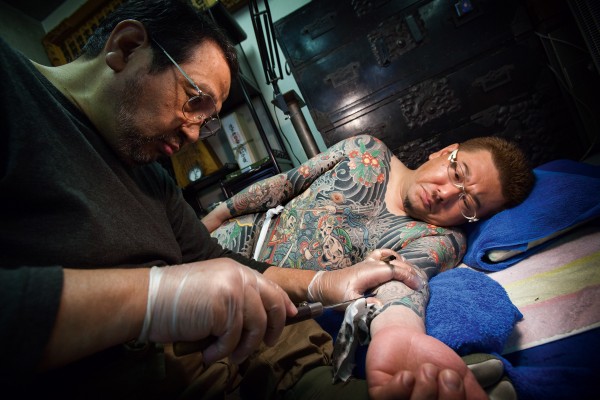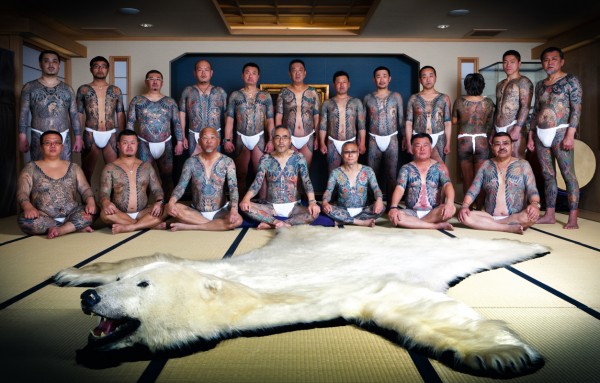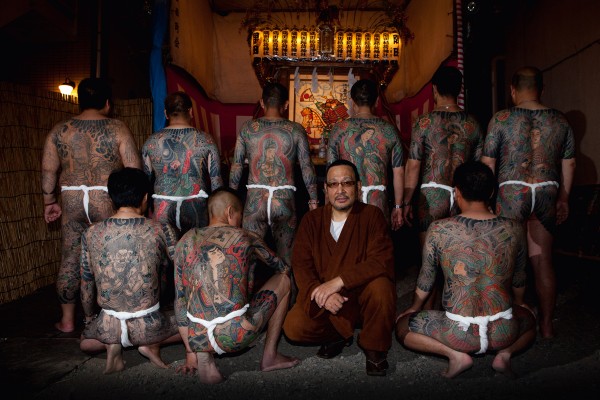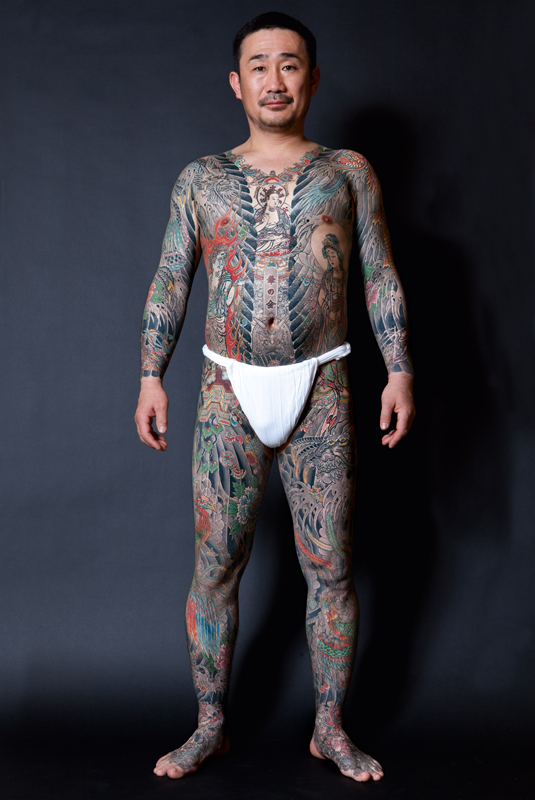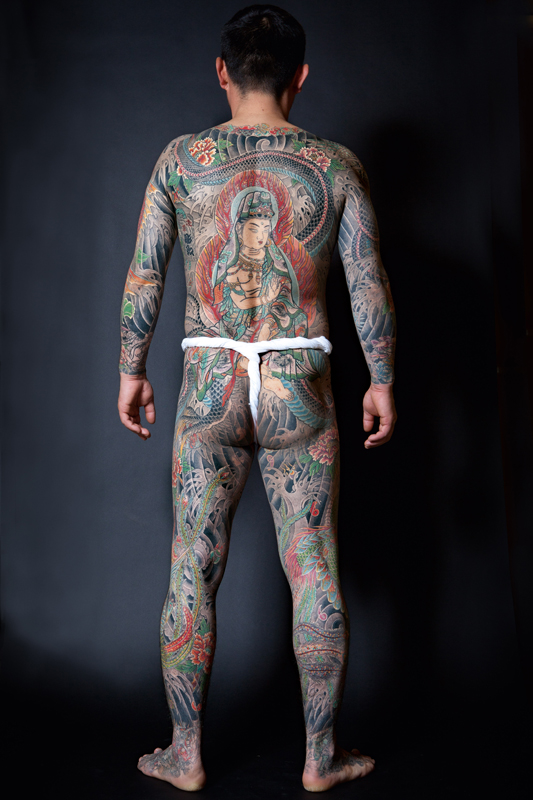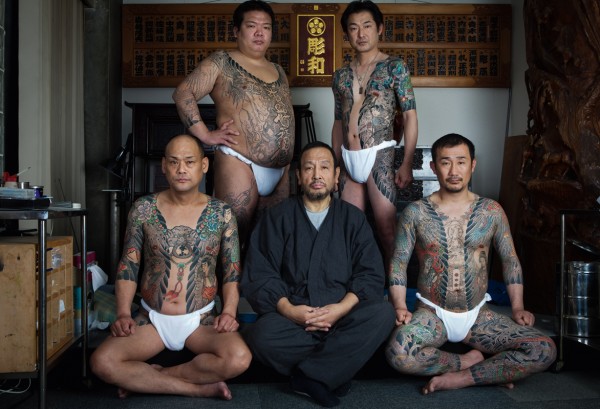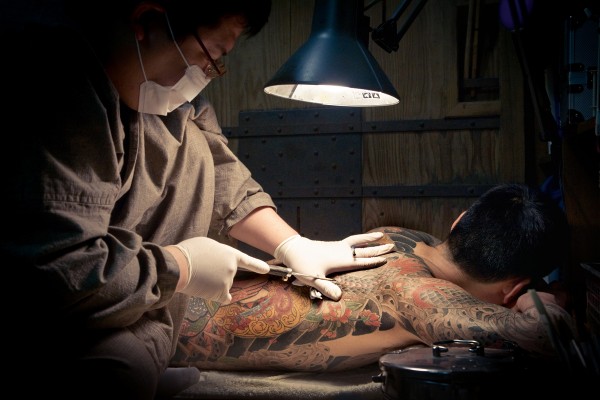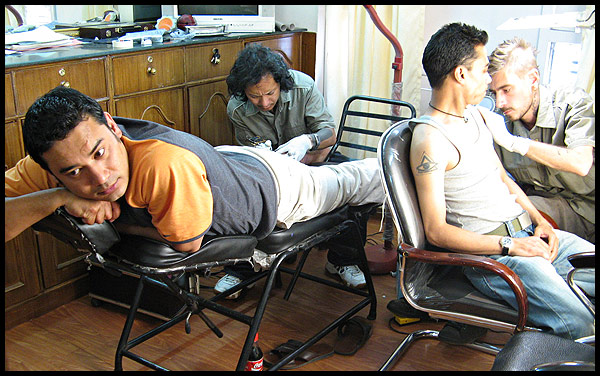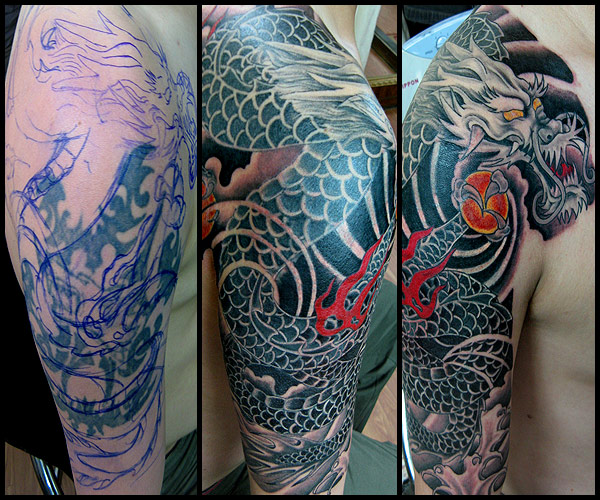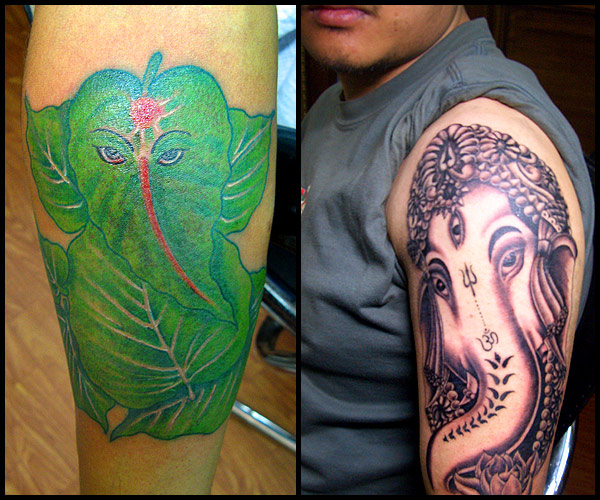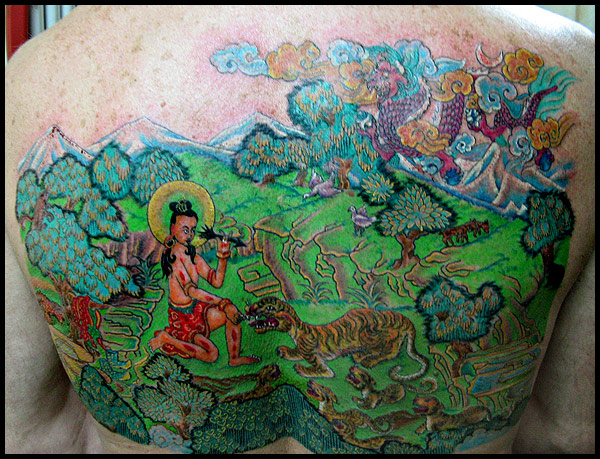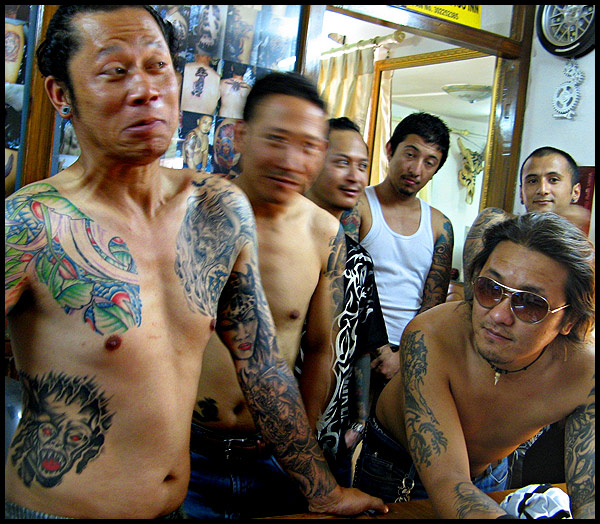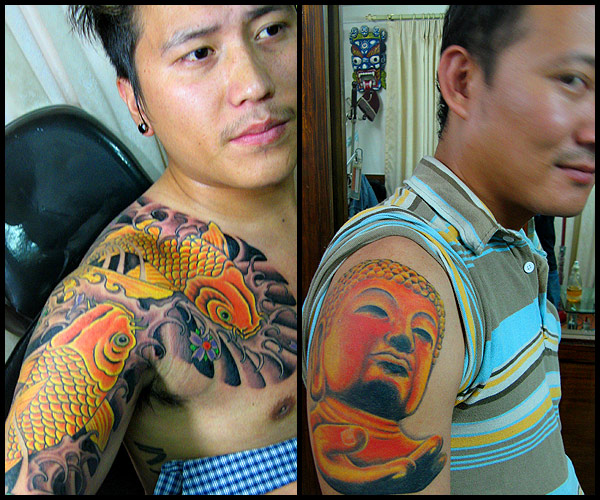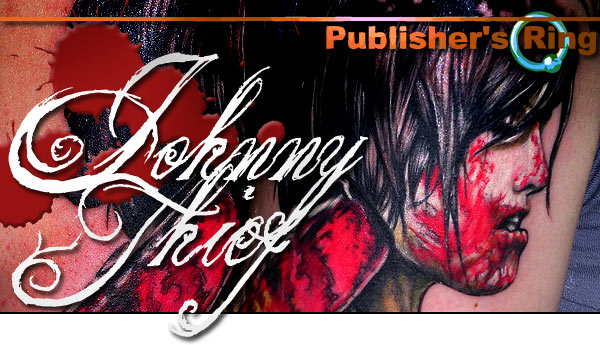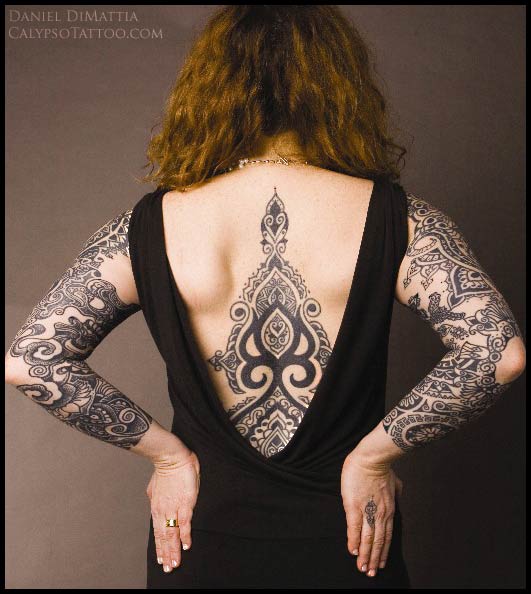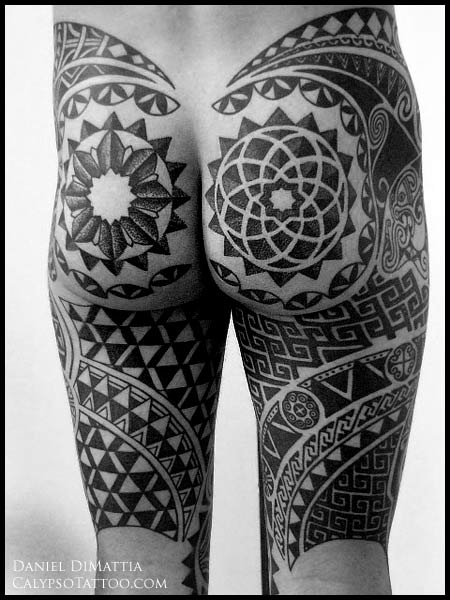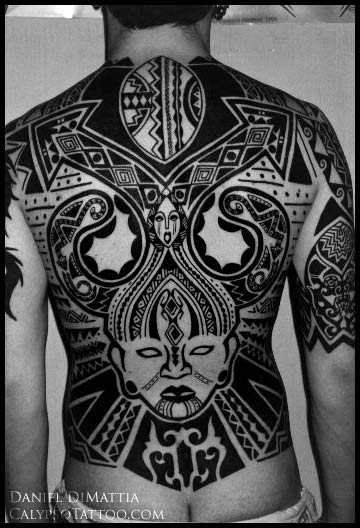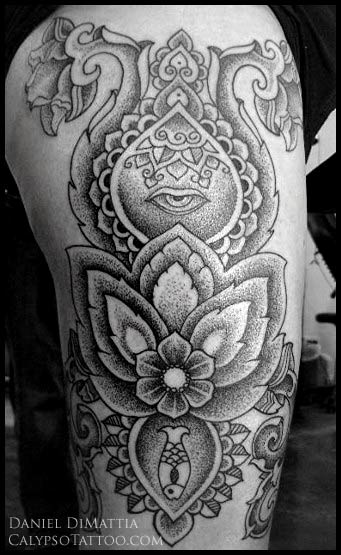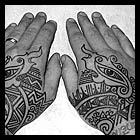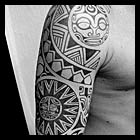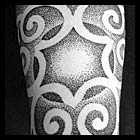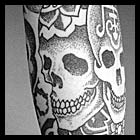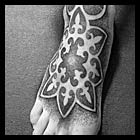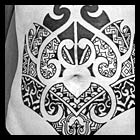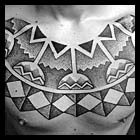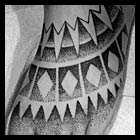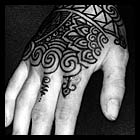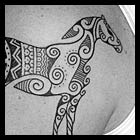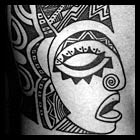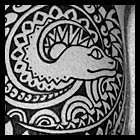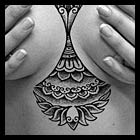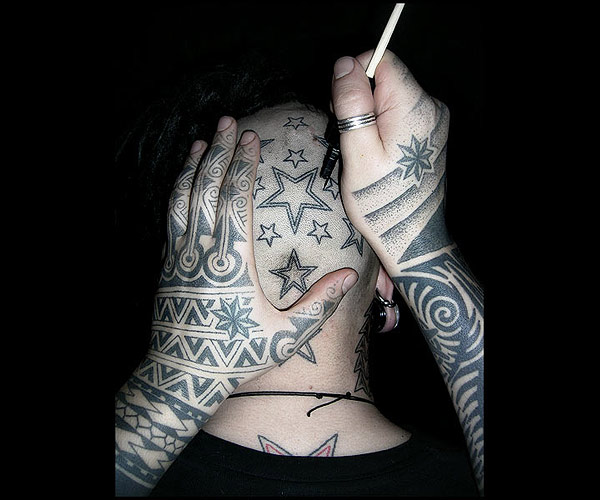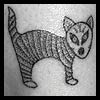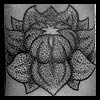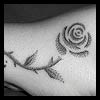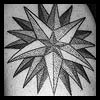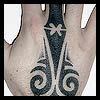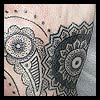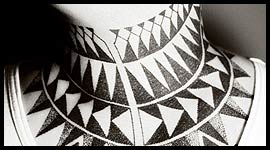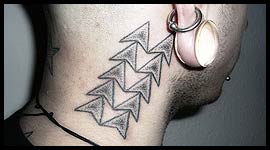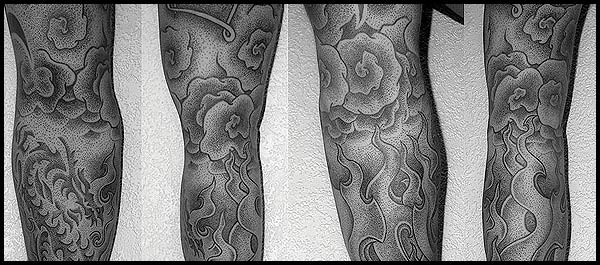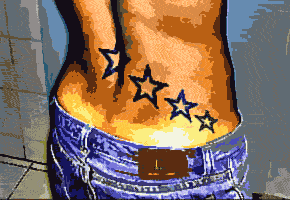|
BME: How did you get into art? Were you an artist as a child, or did it come later?
I have a belief that all artists are born artists. Oh, I know people can be trained and educated and then work in the arts, but there is more to art than wiggling a mouse or working a Spiralgraph™. That vision to see into other places, that insane burning desire to work through the night, that notion that if you don’t work, you could lose your sanity… these aren’t things that can be taught. They separate Artists with a capital “A” from the rich kids going to art school and thinking they’ll be gallery sensations by the age of twenty.
Art was always there, a God-given talent, and sometimes it’s strange talking about it in such analytical terms. It’s not unlike talking about, ‘How long have you been breathing, and who influenced you breathing from early on?’, y’know?
BME: How did you first get introduced to tattoos, and how did you decide it was something you wanted to do for a living?
I worked for fifteen years in various fields of art before ever tattooing. I spent years designing sets, screen printing, designing, art directing, offset printing, prepessing, and building art departments for gigantic corporations. My client list had been huge, working on everything from the 1996 Olympics programs for Reebok to sets for Saturday Night Live and everything imaginable in between.
I always loved tattoos, but I had moved from New York to Florida in the late eighties just before the tattoo renaissance would really reshape the fabric of the scene. Florida tattoos were horrible and I was poor, so no tattoos for me anyway. I had many opportunities to scratch, and I blew them off. People would stop me in the middle of the night, out in Ybor City in Tampa, wheat pasting flyers for concerts, and they would be like, “Man! You’re that guy! You do that fanzine! You’re the THIEF! Man, you need to do my tattoos!” And people would start taking off their clothes and explaining in detail what they wanted… which is alluring when it’s some killer babe. But, I’m checking out area shops, and this was back when Florida was in lock down, arresting 2 Live Crew for obscenity lyrics, arresting Michael Diana for drawing and things like that. I’m thinking, man, it must be really hard to own a tattoo shop, with all these religious freaks trying to close you down, and all the ostracization heaped on them, so without knowing how much that I was doing the right thing by them, I always turned down those kinds of offers.
Fast forward to 1999, when I’m putting my ex through school, and working fourteen hours a day to do it, while all my other friends are creating posters for bands and blowing up in the underground. Knowing that I was dying inside, my ex bought me a starter kit for my thirtieth birthday. One of my good friends was also an employee, Mike Martin, now of Engine House 13, a screen print shop in Columbus. Formerly a trained tattooist from Ohio, he was tattooing outlaw style in Myrtle Beach during the tattoo prohibition. He threw a party featuring nine bands, a custom hot rod show, and me tattooing illegally on anyone stupid enough to sacrifice some skin. (Incidentally, I still tattoo these people for free to this day as a thank you). We called it the Lo Down Ho Down, and there’s a poster we designed for the show published in the ‘Art of Modern Rock’ (by Paul Grushkin and Dennis King, Chronicle Books), my tattoo baptism enshrined for posterity.
After playing around with it enough to get the fever, under Mike’s watchful eyes, of course, I realized that tattooing is no hobby. It’s a 24/7 lifestyle commitment. I started doing crazy amounts of research, and testing the waters. Did I want, at age thirty and with fifteen years of experience, to leave a $60K a year job with full bennies in NYC to go scrub someone’s toilets to maybe become a tattoo guy?
I interviewed Paul Booth, Shotsie Gorman, and Brian Everett for our online fanzine, the Black Market Manifesto. They’re great interviews, but I was really picking their brains about their career choices. I attended lectures at the Museum of Natural History on Body Arts through history, given by Hanky Panky, Don Ed Hardy, Chuck Eldrich, Lyle Tuttle, and a number of masters. I went to as many conventions as I could and started taking seminars. I collected more and more tattoos, and started trading work with some of the artists at their invite, one of which was IAM member Johann Florendo of Queens, which was really flattering.
I finally applied for a job with one of the top studios in the tri-state area and was hired. It was a devastating amount of work. But the cool part was, once I started getting my chops, the old corporate job was bought out and sold, and the new owners liquidated 90% of the spots. Tattooing provided me with job security, ha!
BME: What did your family think of you becoming a tattoo artist?
My family has no idea I’m a tattoo artist, I have not spoken to them since 1992.
My formative years were terribly abusive, growing up in NYC in the 70’s at the height of its crime wave, to underage parents who had no concern for me at all. Art and NYC go hand in hand; unlike other parts of the country, NYC loves an artist, the schools loved me because I wasn’t some thug or gang kid, and the only ones around me who hated me being an artist was my family. As a teen, I’d be kicked out of the house for painting, and forget it, when I started painting sets at a theatre, everyone was sure I was some sort of mezzafanuch… in fact, there was a point I had to sneak in to the city, as my drug addict step father forbade me from going, based on his illiterate fear that I would catch AIDS just by walking around the city streets and then infect and kill the entire family.
My parents would beat me for wanting to be an artist. I had to fight tooth and nail for it. It’s one of the reasons why I get so passionate about art and so nauseated at bad artists, or people who think being an artist is an easy ride for rock stars, doodling all day, banging painting models, and going to art parties all night long. Bullshit, my stint as an artist hasn’t just been a few resumes worth of work, there’s times it’s been an out and out war. I’ve also tattooed in places where it was illegal, add that to the mix, fighting the government for your right to create art, and you get an idea of why I have no problem tearing someone up for sucking.
BME: How did you learn and refine the craft of tattooing?
Oh, that is still actively going on, my friend. Tattooing is seriously difficult, more so than any other medium, it’s a consistent challenge every day. Obviously, you’re working on a living medium that differs from person to person. As an artist, sometimes you really need to turn off the creative and concentrate on the application. It’s a ton of technique, some real hard and fast science. The art part of it is almost an afterthought.
I made sure that once I was committed to the tattoo lifestyle, that I served a complete apprenticeship under a reputable master, (Mario Barth, back when he had only one Starlight Tattoo, in my case). Practice of course helps. Getting tattooed by masters and sitting at their feet and learning from them, of course, one of best ways to open your eyes and take things to the next level. I’ve been slack in that area: I was too busy making a lot of money for people who didn’t care about art or me. But now I work for myself, and this year I’ll be out of debt, and am starting to look to Europe and Japan to get work from my heroes.
BME: Who are your influences as an artist and as a tattoo artist?
My influences, jeez, there’s a book. I’ve had so many, it’s rough to condense it all, I’ve got interests as diverse as classical renaissance art to graffiti, and everything in between. Although I love inkwork, so I’m a huge fanboy of the Romitas, Miller, the Hernandez Brothers, Shawn Kerri, Rick Griffin, and anyone who can work only in black, and create a universe out of it. I love comics (Marvel, DC, horror, Japanese manga, punk, underground, independents) movies (sci fi, horror, foreign, film noir, animae, kung fu, samurai, monster, and really weird cult shit) art (nuovo, impressionism, surrealism, cubism, chiascurro, abstract, dada, low brow, pinstriping) posters (Mucha, Griffin, Kelley, Mouse, Kozik, Coop, Kuhn, Pushaed, Mad Marc Rude, and all my friends and peers) tattoos (Americana, Japanese, new school, grey, color bomb, whatever, it’s all killer)… and the tons of subcultures I’ve been involved with, like motorcycles, punk, ska, hardcore, zine publishers, literature, writing, sex and erotica… it all contributes.
And damn, there are more and more talented bastards coming out of nowhere every day. Who doesn’t love Filip Leu? He’s a genius and easily the best tattooist alive today. I love Jack Rudy’s ethics. Same with Norman Keith Collins (Sailor Jerry) and Paul Rogers… ethics are constantly being eroded in this field and we could still use some of those old school values to preserve the craft for future generations. Bugs was a huge influence on me for a lot of reasons, I also feel he’s really underappreciated in the scene. Mike Rubendall’s commitment. Niko’s realism. Grime’s next level shit. Adrian Lee’s vision. Chris O’Donnell’s structures. It’d be easy to go on all night…
BME: What are some tips that you would offer to new tattoo artists to become the best they can be?
For starters, never think this is going to be easy. No one ever became great because things were easy. You think Martin Luther King Jr. was a great man because it was easy? This is not a profession for the faint of heart, for slacker laziness, or for piss poor gimme gimme “I DESERVE IT” attitudes. My marriage ended and I will never work in any other field because of my decisions; I made sacrifices that this business demands. Turn off the My Chemical Romance and start acting like a fucking man. (Girls, you know what I mean!)
Second, forget about shortcuts. Scratching out of your house will teach you nothing. It will simply put money into the pockets of sleazy companies that will ship ‘tattoo supplies’ to your home. These companies are not run by tattoo artists, and their equipment is a joke; lousy ink, meat slicing machines, needles jigged by blind monkeys. The best companies will only ship to health department regulated legal places of business and will require you to prove it.
In NYC from 1961 to 1997, it was illegal in all five boroughs to tattoo. This was from one single trumped up case of hepatitis that came out of a prison. When you scratch, you are breaking zoning laws, health department laws, and biohazard waste disposal laws. In Chatham county, (Georgia) these fines can rack up to six digits and jail time. If you get caught scratching, you could reverse the laws and have an entire county or state go back to being outlawed. You could unemploy every tattoo artist in the state.
In the old days, which were not so long ago, apprenticeships were fucking hard. They were meant to be, they were supposed to weed out the fanboys and act like boot camp, college, and shock treatment all at once. In days not too long past, if you went to a shop asking to buy equipment, you’d leave with broken hands.
In Japan — (*cue the ‘Kung Fu’ TV show music*) — the old rules were as severe as everything else in their culture. You didn’t get a bunch of small tattoos that had nothing to do with each other, you would have one single master design you an entire horimono body suit. This suit may take years to complete, and the relationship and respect between artist and client was critical.
When seeking an apprenticeship, it was like that scene from ‘Fight Club’, which Chuck stole from the practices of Shaolin monks. A prospect would stand outside the temple, with no food, shelter from elements, or encouragement for days, being berated, screamed at, maybe attacked. If the prospect endured, he was allowed in to begin his training. Japanese apprentices shave their heads, like a monk… what they are doing is sacred to them. They move in and live with their sensei, their apprenticeship is 24/7. They will not tattoo for two, maybe three years at all. They will do everything from cook, clean, to anything asked of them. If they screw up, they are beaten.
They study the history, culture, and sacrifices of all who came before them. They will draw until their hands fall off, become master calligraphers, and water color painters. They will study ukeio-e woodblock techniques, and understand the full range of mythology and religion descending from Shinto, Buddhism, and Bushido. When they tattoo, they will be using instruments made and handed down for generations. When they graduate, they lose their old name. They are adopted into the family, and given a two part name: Hori, which means literally to engrave, and also a new family name… like Horiyoshi 3… Now a family member, they will work with that master for at least five years, as a tribute back to his generosity. He may work with that master for the rest of his life, or he may find his own path.
The artist doing the apprenticing is a world class master with decades of experience, who commands the respect of both an international clientele as well as artists worldwide. He has contributed to the industry in many ways, elevating the art form, improving technique and materials, and upholding the ethics, self policing the industry. This level of respect allows him to easily tattoo everyone from working class laborers to the highest level of Yakuza officers. When a hitman bows to you in respect, you are doing something right.
An apprenticeship will teach you far more than how to tattoo. It will teach you VALUE for what you have, and have been given, value for your clients sacrifice of blood and skin, and value for how hard it was to get to this place in history and to not squander it lightly.
BME: What are your favorite sorts of tattoos to do?
I just love to tattoo. I love the look on people’s faces when they are just blown away. Challenging pieces, photorealistic pieces, things that are just a bit over my head are great, they teach me to stretch and grow. I love tattooing complex designs that my old boss would say were impossible, like wood cut effects, or a color portrait, mostly just to spite him. But sometimes, tattooing is as much about the ritual and bloodshed as it is about the subject matter. You know, like when people need a tattoo as opposed to just want a tattoo.
I still love the basics of tattooing… I haven’t lost that first love of the gig. I get excited ordering supplies. I love unpacking a new machine or pouring out a bag of new ink caps. I love doing a first tattoo, a swallow, a sacred heart, a rose and a spider web… there’s still a rush from meeting someone you may never have met anywhere else, and having the chance, with a small clean tattoo, of changing them forever.
I’ll tell you something funny: I don’t think I’ve tattooed any of my other art on people, like my posters. Yet, I see it tattooed by other tattoo artists all the time. Someone a state over did a beautiful rendition of the winged girl holding a baby skeleton from my Godsmack/Deftones poster… I was jealous!
BME: What are your favorite sorts of clients to work on?
The kindred spirits, naturally… people who know who they are and why they are here. Strong individuals who come in, sit, get a fucking tattoo, a tattoo that is 100% who they are inside, now tattooed on the outside, and go out to kick ass. It makes you feel like an armorer, or an arms dealer.
BME: Least favorite?
Ugh. It’s getting worse. The dumbing down of America certainly has wrought some damage, huh? I hate tattoos of inclusion. When someone doesn’t know who he is and is getting something to belong. Not belong to something he created or revolutionized. Belong to some vapid institution or brainwashing that the arts have railed against for centuries. Someone who doesn’t know what it is he’s getting or why. Like all these nautical stars on emo kids, never knowing why the word nautical is there, on a kid who’s never even seen the ocean. A tattoo that brands you as a group and a follower, and not as the unique individual you are. I call them an anti-tattoo.
Or crosses. Ugh… I hate a cross tattoo. Nothing can be safer than a cross tattoo. Who’s going to get pissed at that? Praying hands. Doves. That Icthus fish. All Christian bumper stickers ripped off a pastor’s bumper. Do not get me wrong, I am not anti-Christian, quite the opposite. Remember that Jesus was crucified with thieves, it was a thief on a cross who was first promised the kingdom of heaven. But, you get someone who has to have the praying hands with the rosary beads and a dangling cross, with another big cross behind it, and a dove, and a banner with the word “FAITH” in it, you know, just in case we didn’t catch all that with the five other symbols in one tattoo… so, you’re tattooing this Bible bookstore nightmare, and he’s on his cell phone, talking to his wife. Then he hangs up and calls his girlfriend. WTF? Or brags about how he’s dodging child support. Or calls his dealer for a bump after the tattoo. These are all fakers who have no idea what they’re getting or why. But, they can go to Thanksgiving dinner, and instead of getting hell from grandma about their tattoo, she will most likely kiss it. I call bullshit.
The Bible is 3500 years old, 66 books long. It inspired people like Mozart and Michaelangelo, inspiring some of the greatest works of art in mankind’s history… In fact, there are portions of the Bible that indicate that the arts are gifts from God, supernaturally given to us by Him to glorify Him, like the artisans who constructed the temple of Solomon or the Ark of the Covenant, or King David who invented a number of musical instruments… the BEST you can come up with, endowed with all your faith and supreme being power, is bringing in your friend, rolling up his sleeve to show me his John 3:16 tattoo, and say, “I like this. Gimme one of these?” UGH! I’ve had guys ask for a cross tattoo, and when I ask where they’d like it, they roll up their sleeve and all they have is cross tattoos. They look like fucking Arlington National Cemetery!
An example, a kid came in, and he’s asking me about a tattoo. He’s like, “You know that verse, ‘My Brother’s Keeper’? That’s what I want, My Brother’s Keeper.” I’m like, “Sure I know that verse. Who doesn’t, it’s in the first three chapters of the Bible. It has nothing to do with being your brother’s keeper, in fact, it’s the exact opposite. Cain said it to God after he killed his brother Abel, asking ‘Am I my brother’s keeper?’. Now, if you plan on killing your brother, then by all means… ”
See what I mean? Here’s a kid who not only missed the point utterly, he has the whole lesson completely ass backwards. A country that is SO obsessed with God this and God that, but has no fucking clue what their own book really says at all.
So, no. I didn’t spent twenty-five years of my life creating art to help perpetrate ignorance. Sorry!
BME: If you could choose any three tattoo artist to be tattooed by yourself, who would you choose and why?
Horiyoshi 3, Filip Leu, and Robert Hernandez. Because they are the best in the world, and I can only imagine the wealth of knowledge I’d gain just by sitting in supplication at their feet. Then Paul Booth, Grime, Marcus Pacheco. Tin Tin. Boris from Hungary. I’d always get more Bugs work. These are cats operating on planes that grunts like me can only aspire to.
BME: What do you think about shows like “Miami Ink” and the mainstreaming and extreme popularity of tattoos? What’s good about it and what’s bad about it? If you were offered the opportunity, would you appear on such a show?
I hate these shows. I do not watch TV and I do not currently get any channels, but the premise of the shows is flawed at the base. It’s corporate assholes who own and dictate the show, then package it and sell it like it was cologne or motor oil. They have no idea of the legacy of our history, or how hard it was to bring tattooing to where it is today, and certainly weren’t there when we fought for legalization. When money is the focus, art dies. From what I hear about the shows, they are long on drama, short on education. And I can’t stand the idea of tattoo faux pas being broadcast nationally; like when they’re doing set ups without any gloves on, wiping fresh tattoos bare handed, or Kat Von D is brushing back her hair with bloody gloves and just keeps on tattooing.
And I know how cool it is to have Steve-O tattoo you, trust me, I’ve done stupider things with tattooing myself. We all have and still do. But why on earth present that to the public? That’s a right that tattoo artists have earned, to do retarded things like go to a convention and then tattoo each other in a dark room under the influence of various substances. Instead, here you have an unlicensed, untrained person tattooing on national television, showing how the tattoo community likes to break health department laws for ratings. STELLAR.
Here’s a killer idea on how to make tattoo TV work: Pick an artist every week, someone up and coming, but not like some megastar. Let’s say like an Aaron Bell, a respected cat in the community who throws down like a motherfucker, but isn’t the owner of several clothing lines or a chain of McTattooshops. Send this person somewhere they’ve never been to explore both the territory and then to seek out the indigenous tattooing. Like some tebori hand tattooing in Japan, get some work in Paris from Tin Tin, or on a beach in the Fiji islands. You would be exposed to a different culture every week, plus see tattooing permeating cultures globally, and have the benefit of a sharp tattooist to illustrate things to the layman. It’s win-win-win, and would be really interesting TV, without all the fake drama or star fucking.
Tattooing is thousands of years older than TV, movies and marketing. Please, corporate whores, stop dragging it down to the lowest common denominator.
BME: What direction do you think tattooing is going in and what does the future of tattooing look like to you?
Haha! I have an issue of ITA that is from 1998, with an interview of Aaron Cain by Dave Waugh, done while they’re on a golf course. It’s amazing. In the article, Dave asks Aaron the same question, and it’s comic how off he is on his answer. He had figured tattooing had hit it’s saturation point, and couldn’t possibly be more exposed. This was before any of the bike build off shows, tattoo TV, the glossy Madison Avenue magazines like Inked, or online banner ads for home mortgages being drawn by animated tattoo machines.
So you want me to go on record like poor Aaron? 😉
I say, I think it’s a scary time: two illegal wars, prison camps, sanctioned torture, trillions in debt, fixed elections, suspension of Constitutional rights, illegal wiretapping, unemployment, falling markets, devalued dollars, the class gaps widening… this country is more apathetic than its been in ages. How many laws do these polesmokers have to break before they’re dragged off to the Hague? Seriously, Dick Cheney could rape someone’s mother on TV, and there will be some fascist pundit justifying it and saying what a whore the mother was and she was asking for it. I have no idea what is going to snap these spoiled, fattened, apathetic losers out of their funk, but I fear it. It’s going to be a second great depression, war with China, or a nationwide Katrina. It’s going to get really bad before it gets better. Tattooing will of course survive. It’s watched things like the pyramids being built and fall into ruin, it will definitely have a shelf life rivaling radioactive waste. And tattoo artists will continue to thrive; during the last depression, the entertainment industries thrived, even with money so short. I just can’t wait until the mall mentality shatters so we can get back to caring more about people than we do about stuff.
BME: How do you feel about tattooing hands, faces, and other “public” skin? Do you do any screening of clients?
Sure. The first and only time I called the cops was on a nineteen year old who started trashing the shop when I refused to tattoo a skull and crossbones on his face. He was just out of prison on a drug charge, was a father already, was beating the mother, (also a client, who covered up his name on her neck after having it for all of two months) and had only one other tattoo. Instead of seeing where I was coming from, that it wasn’t worth the $50 I’d charge him for the tattoo to unemploy him from 98% of the jobs in this country… he felt I was ‘disrespecting’ his manhood and started throwing our portfolios around, screaming he’d burn the place to the ground, and that I didn’t know “who I was messing with”. I was pretty sure I was ‘messing’ with a 140 pound teenage ex-con, so I called the cops rather than snap his femur with my steel toes.
If the kid had some serious work gong on, some sleeves or a big back piece, and had a secure form of income, a trust fund, or a recording contract, then it may have been a different story. I take each client on an individual basis, regardless of the tattoo. I tattoo hands, fingers, feet, necks, and ears all the time. But the same ethics that makes us a quality shop doing clean work also makes us stop and exercise some small amount of social responsibility.
BME: How often do you turn people away, and why?
More and more as time goes on. We get a lot of people in and out who treat our shop like the food court. They want it fast and cheap and they want it now. When informed that the wait might be as long as thirty whole minutes, they stomp their feet and ask where the next nearest shop is. So, after showing them an entire portfolio of before and after shots, I send them on their way, and I don’t feel bad about it at all. We also get a rash of people who come in with a grocery list of things they need in a tattoo, several different subjects, a cover up, must go from hip to hip… no problem, until they tell us that they’re working with a $40 budget for several hours of work. Haha! Right now it’s just me and my amazing partner, Matt Lukesh, so walk-ins can only be done during the slow times. A LOT of people leave, thinking all tattoo shops are the same.
The only real subject matter I turn away are blatant racism or white power tattoos. I have zero tolerance for that shit. But luckily, our clients for the most part keep us interested. We get to do some tasty things and they’re usually somewhat open to exploring outside their boundaries.
I’m also sort of against all white tattoos, because I know how our own melanin will obscure even my best efforts and do not think I can deliver a quality product. And not a fan of black light tattoos. I don’t trust the company producing the ‘FDA approved’ inks, when you examine the release forms and find out the ink was developed for use on fish. Besides, how often are you in black light? Even the owner of a chain of strip clubs isn’t in black light enough to go through the pain and expense… more often than not, it’s a gimmick used by people who don’t know how to put in regular tattoo ink.
Although, to my chagrin, I use three colors from the Skin Candy line of pigment that are also completely black light reactionary, as well as looking great under daylight, and not one single case of dermatitis or reactions. D’oh!
BME: With galleries starting to exhibit tattoo and tattoo related art, do you think this is a good thing, and do you feel that tattoos are “fine art”, or are they “folk art” or “craft” or something else? How do they fit into the larger art world, if at all?
This is funny, because our entire front lobby is the Drowning Creek Rock Art Gallery, with a full display of screen printed concert posters done by Jeff Wood and his impressive roster of artists, from Coop, Frank Kozik, Alan Forbes, Jermaine Rogers, Mark Arminski, Stainboy, Jeral Tidwell, Jason Goad, and myself. We’ve had a number of signings out of the shop, a few art shows, and display some of our original art as well.
As a professional artist, you realize that the gallery scene is kind of a bogus creation. Gallery owners are quite often viewed as scum: many sell art for a 50% commission. 50%! Who else gets 50%? Loan sharks in Brooklyn are jealous of 50%! A lot of what makes a successful artist in terms of pay scales and exposure is a lot of whoring, ass kissing, and nothing to do with Art, capital “A”.
The lines are getting blurred in as much as you have so many more fine artists taking up the tattoo profession, but are not stopping their former careers either. So you have tattoo art that is without any debate fine art. And it’s the kind of thing that will never provide a proper answer. Throughout the ages, the greatest artists in history were rarely the most lauded in their times. Some were shunned by critics but had commercial success, some so far ahead of their time that they failed to hit in any way at all until far after their prime.
BME: Have you ever apprenticed someone? How did you choose them and what was the experience like (and if you haven’t — would you apprentice someone, and how would you choose them)?
I have not, I’ve only been tattooing eight years. I figure I have another decade before I’d be ready to take an apprentice. Most likely my apprentice will be the hottest barely legal Japanese girl ever born, a demon possessed nymphomaniac sado-masochist and exhibitionist, with a hardcore fetish for larger, older, ugly Italian men. Luckily, I do not show a bias in my selection process.
BME: If you weren’t a tattoo artist, what do you think you’d be?
I was born an artist, I was doing art for fifteen years before I was ever tattooed. This last year alone I also did a number of concert posters, DVD covers, one real painting, and our work was featured throughout Guitar Hero 3, on top of running a tattoo shop 90 hours a week for 52 weeks. I would love to have the luxury of painting more often, and be one of those guys who can bitch about the gallery owners taking 50% of a $25,000 painting.
BME: Do you plan on tattooing your whole life? Are you planning for retirement?
Yes, I will retire. When they nail me inside a pine box. Or how about we get all Charlton Heston on it? “I’ll stop tattooing when they take my tattoo irons from my cold dead hands!”
That was pretty tough guy; right?
I have the words UGLY FUCK tattooed on my knuckles. I’m so in this for life. Sleep when you’re dead!
BME: Have you experienced physical problems from tattooing (back, hands, etc.)?
My partner does. The funny part is he is the skinny good looking one. He smokes like a fiend, eats only cheeseburgers, and gets winded opening a sterile pack of needles… he has all kinds of back pain, and is at his doctor weekly. Me, I’m almost three hundred pounds, the largest I’ve ever been… but my doctor declared that I’m “very healthy”, I have great blood pressure, clean lungs, and 20/20 vision. Thick rubber grips on my tubes and the occasional massage help keep carpal tunnel at bay. If I can get back in shape and drop this small child’s worth of extra weight I’m lugging around, I’ll be doing pretty well.
BME: Do you find being a tattooist helps or hinders finding “that special person”? Does it interfere or help at all with your social/personal life?
Being an artist is weird. I’m bitterly divorced… I’ll skip the play by play. When my clients tell me what a great catch I’d be, I tell them that artists aren’t stable people, artists cut off their ears.
I’ll be forty in December, I have a hell of a lot of notches on my belt, and yet I don’t know one goddamned thing more about women than I did when I hit puberty. I have a suspicion that they all work for Satan.
Although I haven’t really dated anyone in the scene who was a professional. I’ve hooked up with plenty of artists, but oddly enough they never wanted to hear about any of the things I’ve been working on, they just wanted a booty call. I guess as far as inspiration is concerned, my tongue has better uses than all this talking.
BME: What are your feelings about the rising popularity of scarification and other forms of body modification as opposed to tattooing, which has a much larger modern history?
I’m glad to see it. Apply everything I’ve said about commercialization and the superficiality of our plastic disposable mall culture to this question. Anything that gets us away from being drones and back to being actual humans again is just fine by me.
BME: How do you feel about scratchers and lower-end tattoo shops, and their role in tattoo culture?
I despise scratch shops. We just had two shops close here in Savannah, neither made it more than a year. One, the owner was a wannabe 1%er, a biker with no patch, who never tattooed, never drew or painted. Two of his artists left within days, the remaining artist had been fired from three separate apprenticeships from the worst shops in town. I’ll give you an example of the kind of shop this was. A cat walks in, knowing the owner deals heroin. He hates tattoos, has no tattoos, doesn’t want to see any tattoos, will never get tattoos. He scores, and asks if he can crash in the back and fix up, which he does. While out on the nod, the owner grabs a machine, and with no training whatsoever, just starts tattooing this guy, the same way you may draw with marker on a friend passed out drunk at a party. The guy comes to covered in scratch that looks like Helen Keller attacked him with a weed whacker… he can’t really go to the cops, how do you explain being tattooed against your will out on a nod? The shop is now closed, because the owner is in prison for drug dealing, weapons running, and murder one.
This is a story I have to tell in 2008?
Now, when I walk into the zoning department or city hall, and introduce myself proudly as a tattoo artist, is this what they think of me? Fuck that! Not to mention, that I’m sure there were days that we were sitting on our hands while they were rocking and rolling. They had plenty of clients all too happy to show up and get stoned… they would pimp that shop as the greatest tattoo shop that ever was. Except now it’s closed and the tattoos look like an experiment in flesh eating bacteria colonies. We live in a time when the Guy Aitchinson’s and Anil Gupta’s have raised the bar to staggering heights, yet these inbred assholes have helped keep people in the dark ages. It’s disrespectful… to all who came before them, to the craft itself, and to all the people they’ve scarred up. This, of course, is just one of the real reasons why we named our shop SEPPUKU. Death before dishonor, gaigin!
When the health department comes in for inspections, I yell at them for being too easy. All that yellow paper tells anyone is that I know how to mop and wear gloves. What I propose, is the TATTOO LICENSE ROAD TEST! Get some prisoners, or kids who want a $5 tattoo, like you get a $5 hair cut at a barber school. The instructor comes out in a bad polyester shirt and a clipboard. He is going to test you on cross contamination practices, skin prep, stencil application, client comfort, lining, shading, coloring, bandaging, aftercare, sterilization and biowaste disposal… you get three hours to put on a nice clean tattoo, some well done lettering, bright colors, smooth blends, maybe extra credit for real toothpaste whites or special effects. If you fail, you go back to apprenticing and try again in six months. A photo is taken of your first tattoo and is laminated on your license as a testament to your skill. Testing is done once every three to five years. Your license is copied on the client’s release form with a check box to prove they have seen it before you begin work on them.
Why not? The shit is medically invasive. It’s the 21st century. Tattoos are expensive. Imagine a body shop that painted cars like some shops tattoo. Not everyone needs to be Corey Kruger or Mike Rubendall… but if you can’t at least put in a clean rose and a dagger, find another career, please? If you want to suck at your job, go work for the DMV, people expect you to suck there.
BME: Are there any times you’ve regretted your career path?
That’s a tough one. I wrestle with it every day, as I’ve spread myself pretty thin. As I mentioned earlier I’ve been a set designer, a mural painter, an airbrush artist, an illustrator, a fanzine publisher, an art director, a screen printer, an offset printer, a digital artist, a concert poster guy, a wheat paster, a pinstriper, and a tattoo artist. All my peers my age are masters in their singular professions. For example, I have a passing friendship in Coop. He’s the same exact age as me, but whereas I’m only known in select circles and bust ass to make bills each week, Coop is world renowned and lives large in a Hollywood villa with his dominatrix wife and a garage full of hot rods. So it goes with most full time poster artists I know, and especially people who were tattooing for as long as I’ve been working. I started working in ’86, I still rent, I have only the slimmest of savings… if I had been tattooing for that long, geez, I’d love to think how far I’d have come.
Sometimes I wonder exactly how much tattooing played in my wife’s decision to bail. It’s been seven years, and I’m still just a mess. A MESS!
But on the flipside, I’ve had multiple careers, each one by itself is someone’s unattained dream. My resume is as long as your arm. I’ve gotten my hands dirty in such a wide variety of mediums and done some of them really well, a bit of a post punk Renaissance guy. Which is great, too. I’m a tattoo artist who can design everything I need from camera ready magazine articles to signs to business carsd to web sites, and is also in magazines, books, galleries and Hard Rock Cafes globally. This is no bad thing either. I never would be that one hit wonder guy, you know, like that shitty guy you hate so much but gets up so much for his specializing in fetish art, or some such shit. I’m glad not to be the ‘old school guy’, the ‘scary monster guy’, or the ‘hot rod guy’, or even conversely the ‘neo-classical guy’. I have some jazz in all kinds of fields of interest and can move in and out of them as a true professional.
I imagine at the end of the day, I’d like to be well off enough to have no limits as to what I want to do with my life; for example, except for Hawaii and the Virgin Islands, I haven’t been off the continent at all. I have a lot of traveling to do, both geographically and spiritually. I don’t like stuff, you can’t take it with you, it’s just dust, after all, but man, if I had the freedom to create art with a capital A, that would be amazing.
Give me some of that time I wasted on suicide, drugs and marriage, let me drop fifty pounds, and come back in five years and see what I can do. 😉
|
 |




